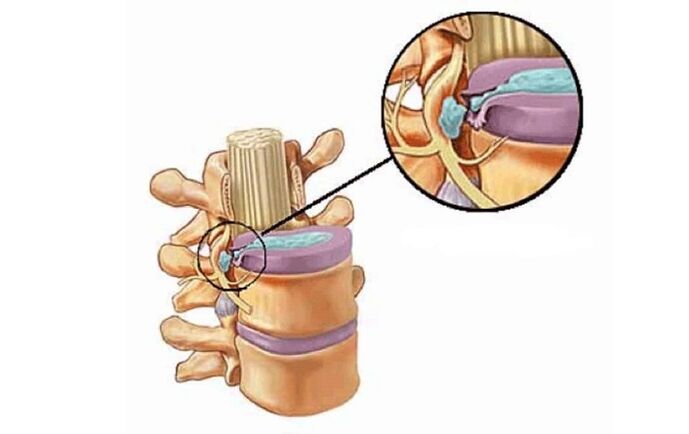Osteochondrosis rarely develops in the chest - the intervertebral discs in it are smaller and thinner in size than in the cervical or lumbar spine. The thoracic region is less mobile, the main load falls on the ribs and sternum.
Unlike cervical and lumbar osteochondrosis, chest symptoms differ only in the location of the pain. The nature of the pain and its duration are similar. In thoracic prolapse, the spinal cord is not affected. Read about this and more.
Stages of pathology
Osteochondrosis usually progresses over time. According to the severity of the manifestation, the pathology is divided into 4 stages.
Preclinical
There are minimal disorders in the spine. There may be a slight pain syndrome, the back muscles are tense. It is possible to develop thoracalgia - chest pain, but this is rare.
Discogenic sciatica
There is a change in the structure of the intervertebral discs. Pain of moderate intensity may occur in the affected part of the spine. The patient is effective. But his indicators of muscular endurance are declining.
Vascular-radicular
At this stage, the fibrous ring is completely destroyed. A disc herniation is formed, the process of deformation of the fibrous ring continues, which leads to its rupture. Then the pulpal nucleus falls into the space under the ligaments. A disc herniation forms. The process affects the tissues located on the disc, the work of blood vessels, muscles, nerves, connections is disrupted. The disease becomes chronic.
Change in the shape of the bone structure
The vertebra becomes rough, its surface becomes ribbed, uneven. Muscles begin to contract spontaneously, leading to limited mobility of the entire spine or a specific vertebra. The nerves that extend from the spinal cord are pinched. This leads to a deterioration of impulses coming from the brain to the tissues and organs of the body.
The mobility of the spine is generally preserved, but the individual vertebrae become fragile and can easily collapse. If the disease is not treated, it progresses to the fourth stage.
Regeneration of the intervertebral disc tissue and replacement of scar tissue
The damaged intervertebral disc is not able to perform its functions well, which leads to convergence of the bodies of neighboring vertebrae. This leads to abnormalities in the intervertebral joints called spondyloarthritis. In this case, torsion or displacement of the vertebrae relative to the adjacent ones may occur.
The body includes its own compensation mechanisms. To relieve the load on the damaged disc, the vertebra is straightened and grows in width. Thus, its area increases. And the tissue of the annulus fibrosus that has collapsed can be replaced with bone.
Sometimes this reduces the pain, but as it grows, the vertebrae make the spinal holes even narrower - the nerve is compressed.
Symptoms of the disease
The symptoms of osteochondrosis of the breast are often caused by the following factors:
- the patient's age;
- spinal cord injury;
- stage of disease development;
- the patient's condition is remission or exacerbation of the disease.
Symptoms also include:
- radiculopathy - painful damage to the nerve endings of the spinal cord;
- abdominal syndrome;
- heart syndrome, changes in the heart muscle - is characterized by severe pain and does not respond to nitroglycerin;
- pulmonary syndrome: congestion, hypoxia occurs in the lungs;
- paresthesia - a feeling of "goosebumps" on the body;
- pain in the area of the compressed nerve;
- reduced sensitivity to temperature fluctuations and touch;
- disorders of motor function of the spine.
The patient's body temperature does not rise. This serves as a sign that allows you to distinguish the pathology.
The degree of the disease
Lumbago
This is a sharp pain that penetrates the body. Manifested when lifting heavy objects and other physical activity - the pain is similar to an electric shock.
In terms of morphology, unexpected rupture of the intervertebral disc capsule occurs when the load is too great. This traumatic injury irritates the nerves - pain occurs.
The muscles are tense and this is well expressed. Lumbar lordosis is smoothed out. Thus, the load is redistributed and the intervertebral disc is compressed even more, which leads to swelling, which increases the pain.
When the pathology is concentrated in the neck, cervical pain occurs - it is manifested by pain when turning the head and palpation of the neck muscles. In exacerbations, cervicocranialgia is often observed, which is manifested in the fact that a person has a severe headache in the occipital region. There may be tinnitus, dizziness, a feeling of flies in the eyes and teeth hurting.
Dizziness
They occur as a result of narrowing of the cavity of the spinal canal. The intervertebral disc protrudes and compresses the vessels. The brain is unable to receive the required volume of blood. You may experience severe headaches, numb hands and sore shoulders.
Difficulty breathing, which causes insufficient oxygen to enter the brain. This leads to stabbing pain in the heart area.
Intervertebral hernia
At this stage of development the picture looks quite serious - the spinal canal and intervertebral cavities are very narrow. As a result, a hernia can form - a dangerous defect. Often at this stage of the disease it is necessary to resort to surgery.
Treatment of third-degree osteochondrosis depends on root compression. It is possible to use the same techniques as in the second stage. However, when the pain persists for fifteen days and there are symptoms of prolapse (vertebral prolapse), surgery is required.

Vertebral growths
As a rule, at this stage of the disease the manifestations of the hernia disappear, the symptoms of the disease are less pronounced, but it is noticed that the spine is unstable, the vertebrae may slide or twist relative to each other.
At this time, the vertebral bodies may grow - this is called osteophytes. The growths lead to compression of the spinal nerves, there is an overlap of the spinal canal, called secondary stenosis of the spinal canal. As a result, compression of the spinal cord is possible, leading to ischemia.
This stage of the disease includes the consequences of previous operations to remove the hernia. They can manifest as impaired innervation, paresis, inflammation.
Dorsago and dorsalgia
The symptoms of thoracic osteochondrosis directly depend on the area of the spinal cord lesion. The most common distinction is between vertebral syndromes of dorsago and dorsalgia.
Dorsago manifests itself in the form of sudden sharp pain that occurs in the chest area. This often happens if a person is in a sitting position for a long time without changing his posture. Pain can occur when a person's position is uncomfortable from a physiological point of view. In addition, it is possible to perform monotonous work for a long time.
Dorsago is also called "lumbago on the chest". When this happens, the muscles in your back and chest become so tense that it becomes difficult to breathe.
Sometimes the pain passes along the ribs to the sternum, radiating to the scapula. Sometimes the patient may feel that this is a myocardial infarction. However, no abnormalities were detected during the electrocardiogram. If you take nitroglycerin or other heart medication, then there will be no result.

Avoid staying in one position for a long time. Sedentary work is one of the main causes of osteochondrosis.
Dorsalgia is a mild pain that lasts for a long time, sometimes up to these weeks. The inflamed part of the spine gives "dull" pain. This is inconvenient, so the person usually comes to the doctor.
Dorsalgia can be expressed in the fact that:
- the pain worsens when a person inhales deeply or coughs;
- muscles are overstretched;
- motor activity in the neck or lumbar region decreases;
- there is a muscle spasm;
- the pain is stronger at night and when the person is engaged in physical activity.
Dorsalgia is higher and lower. In the first the main painful manifestations are concentrated in the upper chest, in the neck. In the second case it hurts mainly in the sacrum and lower back.
The symptoms of dorsalgia are very similar to the first signs of pneumonia. This is important to remember to diagnose the disease in time. If the diagnosis is incorrect and treatment is prescribed, the patient's condition will only get worse.
When a woman breastfeeds her baby, she may experience such manifestations of osteochondrosis. It is only necessary to treat the disease in this situation, contacting a doctor, taking into account all the nuances.
It is important to consider all the risks of using certain medications so as not to harm the health of the baby and your own.
Atypical symptoms
In some cases, the symptoms of thoracic osteochondrosis are completely atypical. One may not even know about the disease, as the symptoms are often similar to those of other pathologies. They need to be examined in more detail and the situation as a whole analyzed:
- there may be pain that mimics the heart, which develops during angina pectoris and heart attack; coronary dilation drugs, such as nitroglycerin, have no effect; and the ECG shows no abnormalities;
- pain similar to that seen in women with breast disease may occur; this pain can last a long time; examination does not reveal problems in the mammary glands;
- the iliac region and abdomen may be painful, the symptoms are not similar to those of gastritis and colitis; pain below the right rib may be observed, similar to that which characterizes hepatitis or cholecystitis; digestion is usually impaired - this is also a characteristic symptom of osteochondrosis, which occurs due to disorders in the innervation of internal organs; it is necessary to understand what caused the violation of the process of digestion of food, is it really the cause of osteochondrosis of the breast;
- the process of urination and sexual function may be impaired because the innervation of the genitourinary system is distorted;
- when thoracic osteochondrosis worsens, there may be prolonged, weeks, pain in the sternum, very similar to those present in diseases of the mammary gland; a visit to a mammologist allows you to identify the cause of the pain.
These symptoms are associated with back pain as well as intercostal neuralgia. The appearance of atypical symptoms is usually observed in the evening. In the morning, as a rule, no whiter. The pain increases throughout the day if the right conditions are created for what provokes pain.






















